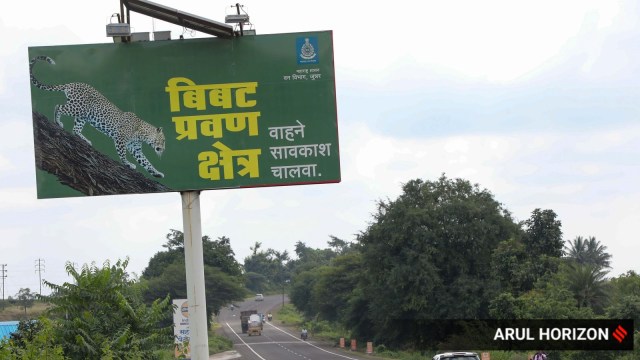Click here to join Express Pune WhatsApp channel and get a curated list of our stories
The Burn Out: As summer gets harsher in Pune, human-leopard conflict trigger concern among Junnar migrant workers
Forest Department says it is closely working with the local population to address the crisis, studies show that the leopard attack incidents rise during the summer months.
 Forest department’s hoarding cautioning the travelers that this is a leopard prone area at Umbraj village on Ahmednagar-Kalyan highway. (Express photograph by Arul Horizon)
Forest department’s hoarding cautioning the travelers that this is a leopard prone area at Umbraj village on Ahmednagar-Kalyan highway. (Express photograph by Arul Horizon)With the onset of a harsher-than-usual summer, the sensitive issue of human-leopard conflict in the Junnar Forest region of Pune has triggered concern for the local villagers and forest officials.
While the Forest Department says it is closely working with the local population, especially the most vulnerable groups of migrant farm labourers, there are some key questions that remain unanswered.
The year 2024 saw eight deaths, including that of five children, in the incidents of human-leopard conflict. These deaths — the second highest toll reported in a year in the last 20 years — had become a key political issue before the Assembly elections.
Observations by forest officials and related studies show that the leopard attack incidents that result in loss of human and domestic animal lives rise during the summer months. The department has said it has intensified its efforts to tackle the issue.
Factors that lead to human-leopard conflict during summer
Among the key stressors of the human-wildlife conflict during the summer months, especially those with leopards are the changes that forest areas go through during this period. The Junnar region, another major factor, contributes to the conflict: the cutting of sugarcane that happens during this period and leads to a temporary habitat loss.
A significant phenomenon observed over the past few years in and around Junnar forest region — like many other well-irrigated areas of the state — is an increase in sugarcane cultivation area in the region. It has been observed that leopards, which are a very adaptive species, use these fields which have thick sugarcane cover, as a habitat. This provides a safe breeding place too. Summer brings water scarcity in forest areas and also results in dwindling prey base, compelling leopards to move more in search of food.
As the sugarcane cutting takes pace, depleting the vegetation cover that leopards had inhabited, they move to other areas in search of hiding places or try to move back to forest. It is during this transit, the possibility of encounters increases.
Countermeasures to human leopard conflict
After the back-to-back incidents of leopard attack incidents in April and May last year, the Forest Department had issued a red alert for 13 villages in a five square kilometre area in Junnar taluka. People in these villages were asked not to step out before 9 am and after 5 pm. Subsequently Pune district collector had notified over 230 villages from four talukas of Pune district — Junnar, Ambegaon, Shirur and Khed — as prone to disaster due to repeated incidents of human-leopard conflicts.
Deputy Conservator of Forest for Junnar Division Amol Satupte said the department has taken concerted efforts towards creating awareness and sensitising villagers. “We are taking help from NGOs and local groups. The people from villages in Junnar taluka have now adapted to the presence of the leopards, in a transition from conflict to cohabitation in the same space. We are taking similar sensitisation efforts in Khed and Ambegaon talukas too which are witnessing instances of leopard encounters,” Satupte said.
Satpute added, “We are working closely with groups and communities that are highly vulnerable. These are primarily migrants to the area. The dwindling prey base forces leopards to target goats and sheeps of the shepherds’ communities. Other vulnerable group is the sugarcane cutting communities who live in makeshift dwellings next to the fields. A large number of migrants are coming to the area for onion harvesting season and face the same issue. The living conditions of these groups makes them highly vulnerable. We are taking concerted efforts to spread awareness among them.”
The officer said they are providing tents to many of the vulnerable groups and have stepped up patrolling and increased drone surveillance in these areas.
Some unanswered questions, concerns
With a growing leopard population in the Junnar forest area in Pune leading to increased incidents of wildlife attacks, the Forest Department last year sent a proposal to the union Ministry of Environment, Forest and Climate Change (MoEFCC) which included a phased plan to sterilise 36 female and 11 male leopards as a targeted birth control method to bring down the rate of increase of leopard population. The proposal had come after Member of Parliament Amol Kolhe had written to various stakeholder agencies to intervene and work towards finding a solution to the human-leopard conflict. This proposal is still awaiting a nod from the Central Government.
Prashant Pable, the convener of the Human Leopard Conflict Action Committee, a local group from Junnar working on the issue, said, “While Forest Department is working in the right direction, a key question is do they have adequate manpower and resources considering the expanse and the intensity of the issue? We urge the state government to look into the issue on priority.”
Considering the large number of leopards in the vicinity of Kukdi and Ghod River, Junnar Forest Division has repeatedly appealed to the residents of Junnar, Shirur, Ambegaon, and Khed talukas to follow key precautionary steps including installing plenty of bright lights around each home and in the fields, use high fences around cattle sheds, completely clearing the grass cover on both sides of the road around the houses and the fields, using toilets inside the house, avoid going outside before dawn and after sunset, and if unavoidable, carry a flashlight and a sturdy stick.
“The measures of lights and fences are not possible for everyone. If we adhere to the time norms, who will work in the fields. Is living alongside leopards practical if the animal population keeps growing?” asks Satish Shinde, a local farmer from Junnar.
Click here to join Express Pune WhatsApp channel and get a curated list of our stories













